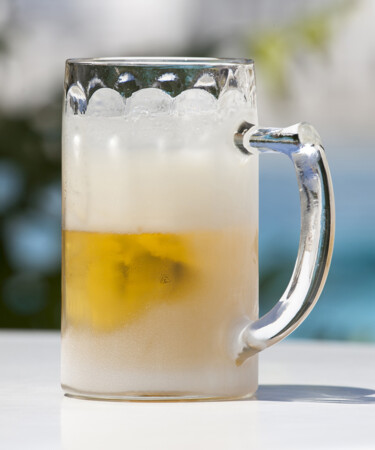
Oh, the sweet, frosted beer mug. Iconic image to bar flies and beer lovers everywhere. Mouthwatering. Coquettish. A bit of beverage pornography in a world of too many opaque cans and chaste beer labels.
But bad news, frost fans. Turns out that sexy, icy beer mug is actually ruining your $8 craft beer, and should probably be banished forever to the land of “nice idea, bad science.”
Okay, maybe that’s too harsh. Frosted steins do have one place in the beer world: “Ice cold mugs are the perfect vessels in which to serve macro-brewed industrial lager,” says Bluejacket Brewery’s Greg Engert, “the kind of deliberately stripped down conveyors of mild intoxication that can only be recommended, if at all, on account of being ice cold, refreshing, and thirst quenching.” Engert’s not just hating on macro brews. Before he founded Bluejacket—where he tinkers with beer styles and nuances of flavor like a (benevolent) mad scientist—Engert became one of the savviest, and earliest, beer sommeliers in the industry. He knows a thing or two about what a beer has to offer, and how it should be offered—as in what glass, and certainly what temp.
So yeah, if you’re going for a macro lager—Bud, Coors, Miller, the list goes on like an Allman Brothers jam session—feel free to get frosty, since there’s not much flavor at stake. But with craft beer, the central concept is flavor, typically lots of it. And the frosted mug is the enemy of flavor. “Served too cold, the volatile aromatics [of craft beer] are held at bay,” says Engert, basically shut out of the nightclub that is your palate by the bouncer that is frigidity. The solution? Defrost that mug, my friend. Warm it, even. Just “a degree of warmth to the beer” should release the volatiles, “eventually evaporating up and out to provide the aromas we cherish from our craft beers.”
Not that we should be nuking our steins. “It’s a delicate balancing act, since going too warm will rob some craft beers of their sparkle, and the refreshing qualities they too can provide in congress with their flavor profiles.” If you haven’t noticed, Engert is nothing if not meticulously specific about how each beer best expresses (meaning you’re lucky if you love beer and can make it to his brewery). And he actually goes quite a bit further at Bluejacket, with a temperature-specific list per beer style (which likely will become the norm, the way wines are served at optimal temp). Again, Engert isn’t hating on a cold brew or nerding out for the sake of it. It’s quality-control. “Craft beer provides a far fuller flavor experience,” he explains. Proper, as in not frosted, temperature glassware is the only thing that can “unleash myriad flavor possibilities.”
So the next time a bartender tries to serve craft beer in a frosted mug, send that glass back with a respectful salute. Goodbye, Frosty. It’s time for some decent beer.
